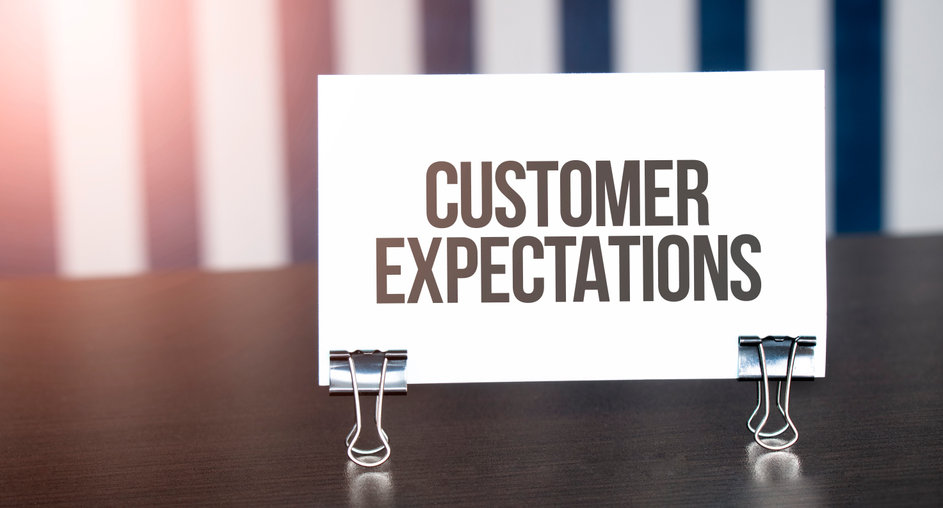
Every business wants to meet the expectations of its customers. From product offerings to customer service to marketing, the clients’ needs and expectations come first. With ongoing advancements in technology and an ever-changing business and societal landscape, understanding and maintaining that standard is no simple task. In fact, 72 percent of marketers say meeting customer expectations is more difficult than it was a year ago.
B2B Clients’ Expectations from Your Business

To keep up with the competition and constantly changing needs, it’s critical to review the most common expectations of B2B customers.
- Customers expect a “transformative” customer experience.
Research shows that 80 percent of customers say the experience a company provides is as important as its products or services. Writer and marketer Nathan Willard takes it a step further. In an interview on Nettie Owens’ podcast What Businesses Need to Know Now Right Now, he said, “It’s not about commodity, it’s not about the product, the object, you sell. It’s not even about the service you sell. It’s about the experience you’re providing. Our customers want transformative experiences and that’s something we need to realize no matter what our business is.”
To create a transformative experience, companies can nurture a meaningful relationship that benefits the customer in a variety of ways through tactics such as:
- Case studies or testimonials that celebrate customer successes and showcase what the customer experience is like with your firm
- Customer-centric events and meetups to further a meaningful connection, create a supportive network and gain direct insights to improve the customer experience.
- Surveys, polls, reviews and other requests for direct feedback from clients and prospects to encourage open and mutual communication and uncover challenges, pain points or ways to improve your business relationship.
- Relevant customer-centric content that provides value, solutions and insight furthers customer relationships throughout the entire customer lifecycle, not just the acquisition process. Use content in varied mediums and share it through multiple channels to connect with the needs and interests of different target audiences. Content types to consider include blogs, whitepapers, bylined articles, podcasts, video, social media, eBooks and print books.
In addition to content creation, how does creating a transformative experience translate into behavior within an organization? It means every individual takes responsibility for going the extra mile to identify what will surprise and delight customers. Whether it’s the way an issue is handled or sending a special greeting card, a book you think a client will enjoy, a gift basket or gift card, or purchasing an award or plaque…all of these are opportunities to increase the personal touch and communicate to clients that they are valued.
- Customers know businesses have their data, so they expect it to be used in beneficial ways.
Seventy-nine percent of service professionals say it’s impossible to provide great service without full customer context. To create this context, customer data and research are vital building blocks for successful customer relationships. Use market research, data analytics and a customer relationship management system to collect, understand and maintain vital customer information, evaluate engagement and anticipate a prospect’s or customer’s future needs. In today’s digital marketplace, users understand that businesses are collecting their data. As a result, they expect it to benefit their customer experience through strategic personalization and targeting that fits their needs and challenges. Personalization encompasses email segmentation, pre-defined buyer personas, targeted landing pages, digital advertising, recommended content or even providing customers with a dedicated, account-based representative. More than half (55 percent) of B2B sales and marketing professionals report that personalization results in higher conversion rates, leading to more opportunities for business growth.
- Customers expect transparency and trustworthiness in brands they can remain loyal to.
According to Edelman’s Trust Barometer Study, 67 percent of U.S. consumers agree “a good reputation may get me to try a product, but unless I come to trust the company behind the product, I will soon stop buying it.” Today’s customers are information-savvy and seek to spend their dollars with companies they know and understand beyond their brand image. Customers expect businesses to be transparent about their products and services, but also about the inner workings of their company, including culture, employment, supply chain relationships and business practices. Consider that 78 percent of consumers believe how a company treats its employees is one of the best indicators of its level of trustworthiness. Further, 64 percent of consumers are willing to buy or boycott a brand because of its position on a social or political issue. Establish trust and transparency through consistent communications, news and updates and by fostering a culture of internal transparency, starting with the company’s larger vision and mission.
The Power of Customer Relationships

When it comes to meeting customer expectations, what we’re really talking about is creating and maintaining a meaningful and mutually beneficial relationship. Just like any relationship, it takes time, effort and understanding to build something of lasting value. Without continual care and attention, relationships can fall apart quickly. Don’t take your customer relationships for granted. Continue to inquire about and consider the expectations of past, current and future clients. When you do, you can communicate effectively and meet customer needs and challenges. The more you communicate your dedication to your customers, the more meaningful and lasting your relationships will be. With an increased focus on a customer-centric mindset, you’ll create a transformative customer experience, happier and more loyal customers, more engaged and productive employees, and a stronger bottom line.
